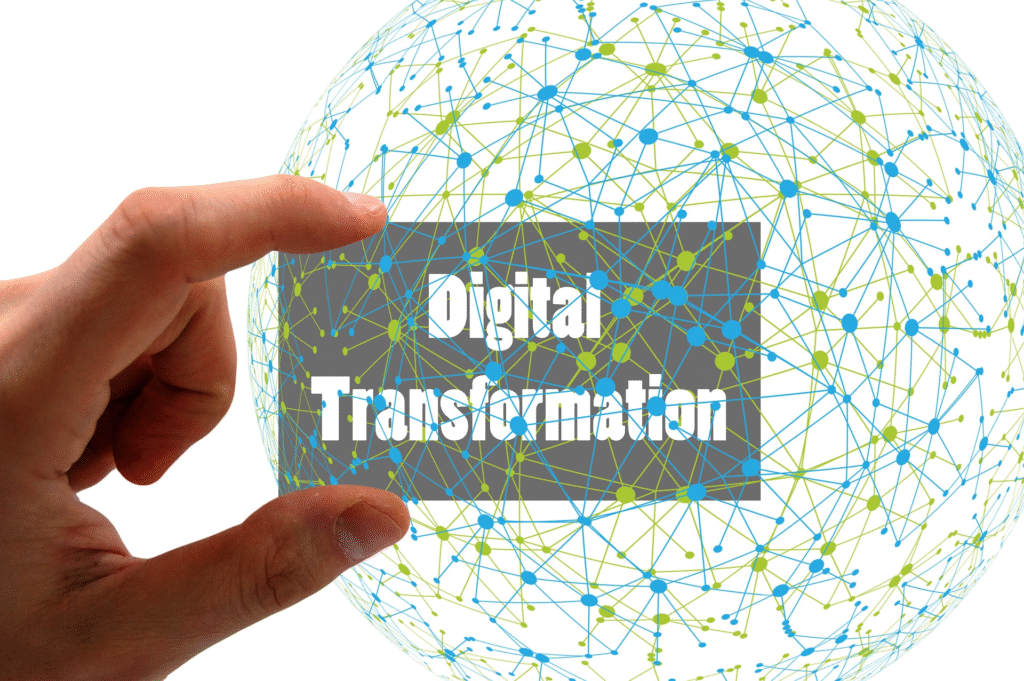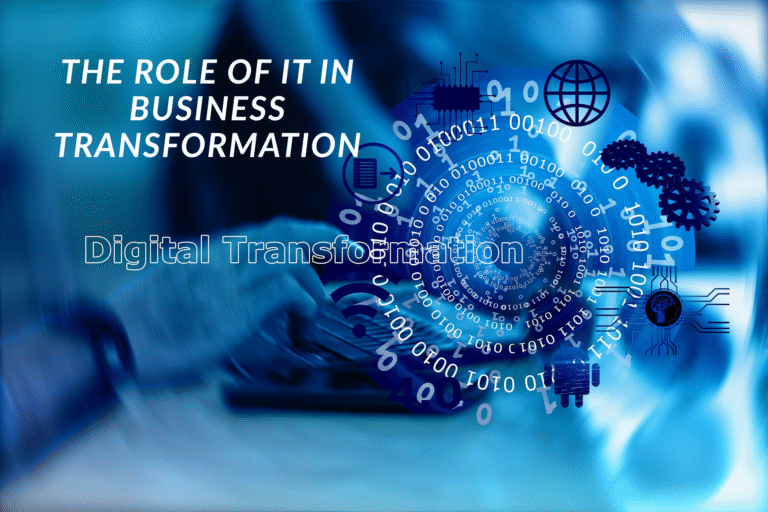The Role of IT in Business Transformation: Information technology (IT) is no longer merely a support function in the fast-paced digital age we live in today; it is now a key factor in company transformation. IT gives businesses the ability to adapt and prosper in cutthroat marketplaces by facilitating automation, data-driven decision-making, enhanced consumer experiences, and operational efficiency.
Integrating IT into core business strategy is crucial for fostering innovation and attaining long-term growth as companies deal with swift technical advancements and changing client expectations. This essay examines how, in the current workplace environment, IT is essential to changing business models, optimizing workflows, and promoting a continuous improvement culture.
The Role of IT in Business Transformation.

The Role of IT in Business Transformation: In the quickly changing digital world of today, information technology (IT) is essential to the development and transformation of enterprises. IT is no longer merely a support function; it is now a key driver of business strategy and success, from improving customer experiences and optimizing processes to fostering innovation and facilitating data-driven decisions.
The main ways that IT supports business transformation are examined in this article, along with practical instances of its effects and the difficulties and best practices that businesses should take into account when putting IT-driven change into practice.
(1) Understanding Business Transformation.
The Role of IT in Business Transformation: The process of drastically altering a company’s or business unit is systems, procedures, personnel, and technology in order to attain quantifiable gains in productivity, efficacy, and customer satisfaction is known as business transformation. This change is frequently prompted by the need to adjust to shifting consumer needs, embrace cutting-edge technologies, or adjust to new market conditions.
IT is the foundation of this change, offering the digital tools, platforms, and frameworks that businesses need to develop and stay competitive.
(2) How IT Enables Business Transformation.

(1) Process Automation and Efficiency.
The Role of IT in Business Transformation: Business process automation is one of the main ways that IT promotes change. Workflow management software, enterprise resource planning (ERP) systems, and robotic process automation (RPA) are examples of technologies that help decrease manual labor, increase accuracy, and save time.
IT solutions, for instance, automate reporting, payroll, and invoicing in finance departments. IT facilitates inventory control and real-time tracking in supply chain management, cutting down on delays and improving logistics.
(2) Data-Driven Decision Making.
Large volumes of data are produced and consumed by modern businesses. IT gives businesses the ability to gather, store, and evaluate this data in order to identify patterns, predict results, and make wise decisions.
Leaders can find opportunities, react to changes in the market, and increase operational efficiency with the help of tools like data analytics, AI-powered insights, and business intelligence (BI) systems.
(3) Enhanced Customer Experience.
Customers of today need seamless, individualized, and quick experiences. Through chatbots, mobile apps, self-service portals, and Customer Relationship Management (CRM) systems, IT helps companies to live up to these expectations.
For example, banks employ mobile apps to give round-the-clock services, and e-commerce businesses use AI-powered recommendation engines to deliver tailored product recommendations.
(4) Enabling Remote Work and Collaboration.
The COVID-19 pandemic has hastened the migration to remote and hybrid work styles, making IT infrastructure more important than ever. With the help of virtual private networks (VPNs), secure cloud storage, and cloud-based communication technologies like Microsoft Teams, Slack, and Zoom, teams can remain productive even when working remotely.
(5) Fostering Innovation.
The core of transformation is innovation. By experimenting with cutting-edge technologies like blockchain, AI/ML, the Internet of Things (IoT), and edge computing, IT departments frequently take the lead.
IT is used by companies that fund innovation laboratories and digital incubators to produce new goods, services, or business models that upend established markets and provide them a competitive edge.
(3) Real-World Examples of IT-Driven Transformation.
Amazon.
One of the best examples of a company that has been impacted by IT is Amazon. It began as an online bookshop and, thanks to its IT prowess, grew into a multinational tech juggernaut. Cloud computing and e-commerce have been transformed by its advanced supply chain, recommendation algorithms, AWS cloud services, and data analytics.
Netflix.
By making investments in cloud infrastructure, big data analytics, and artificial intelligence. These days, a key component of its customer engagement approach is its recommendation engine, which is driven by user data.
General Electric (GE).
By using IT to incorporate IoT and analytics into its industrial machinery. This made it possible for it to provide its clients with services like performance optimization and predictive maintenance.
(4) Key IT Components Driving Transformation.
(1) Cloud Computing.
Scalability, flexibility, and cost-effectiveness are provided by cloud platforms such as AWS, Azure, and Google Cloud. They enable companies to accommodate remote teams, store large datasets, and swiftly deploy applications.
(2) Cybersecurity.
Sensitive data protection becomes essential as firms digitize. With the use of firewalls, encryption, multi-factor authentication, and real-time threat monitoring, IT guarantees strong cybersecurity.
(3) Mobile Technology.
IT supports mobile-first strategies, responsive web apps, and mobile device management (MDM).
(4) Enterprise Architecture.
IT investments are guaranteed to be in line with business objectives when an enterprise architecture is well-designed. It offers a guide for incorporating new technologies into systems that already exist.
(5) Challenges in IT-Driven Transformation.
While IT has immense potential to drive business transformation, companies often face several challenges:
(1) Resistance to Change.
Because they are afraid of the unknown or the possibility of losing their jobs, employees and even leadership may be reluctant to embrace new technologies.
(2) Legacy Systems.
Innovation may be impeded by outdated IT systems. It can be difficult and expensive to replace them or integrate them with contemporary technologies.
(3) Skills Gap.
Finding IT specialists with knowledge in cloud computing, cybersecurity, artificial intelligence, and data science is a challenge for many businesses.
(4) Data Privacy and Compliance.
Businesses must make sure that IT systems adhere to data protection rules in light.
(5) Cost and ROI Concerns.
IT transformation requires significant investment. Organizations must carefully evaluate the return on investment and align IT initiatives with business objectives.
(6) Best Practices for Leveraging IT in Business Transformation.
To successfully harness IT for transformation, organizations should consider the following best practices:
(1) Align IT with Business Strategy.
IT should not operate in a silo. It must be integrated into the overall business strategy, with clear communication between IT leaders and other departments.
(2) Adopt Agile Methodologies.
Agile development allows teams to deliver incremental improvements, respond to feedback, and reduce the risk of large-scale project failure.
(3) Invest in Training and Change Management.
Continuous learning programs and change management strategies help employees adapt to new systems and processes.
(4)Prioritize Cybersecurity.
As digital transformation increases the attack surface, cybersecurity must be built into every IT project from the ground up.
(5) Use Data Responsibly.
Ensure data governance policies are in place to maintain accuracy, privacy, and compliance when using data for decision-making.
(7) The Evolving Role of the CIO.
The Chief Information Officer’s (CIO) function is changing as IT becomes more and more important to business transformation. As strategic partners in the C-suite, CIOs are now in charge of innovation, customer experience.
Conclusion.
IT is now the engine of business change rather than a supporting role. IT affects every facet of contemporary company, from facilitating remote work and encouraging innovation to automating processes and improving customer experience.
Businesses are better to adapt, compete, and prosper in an increasingly digital environment when they view IT as a strategic asset. But success necessitates more than simply technological investment; it also calls for a change in culture, capable leadership, ongoing education, and alignment of IT projects with business objectives.

